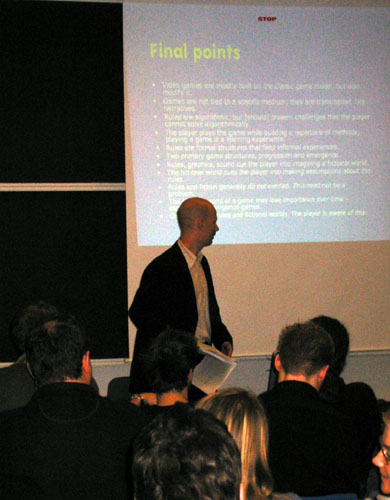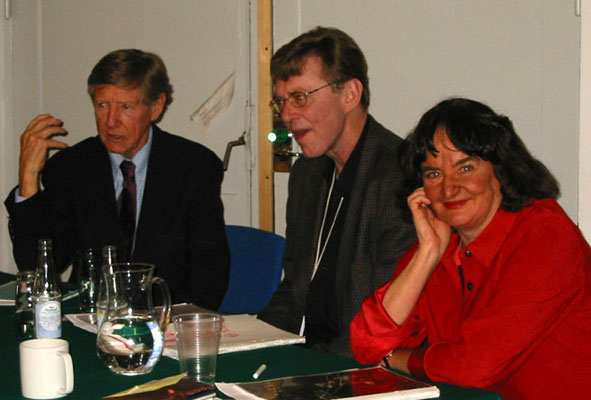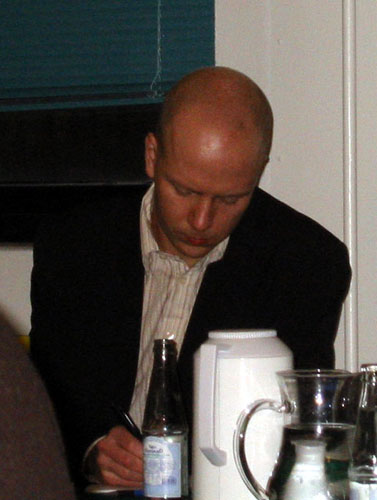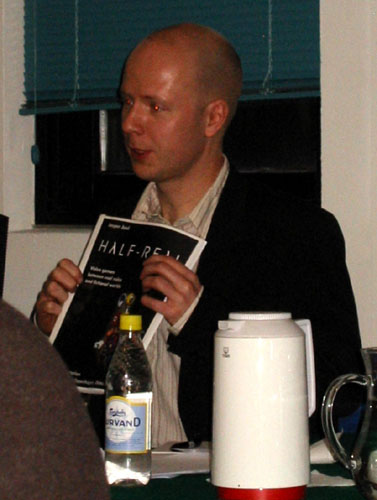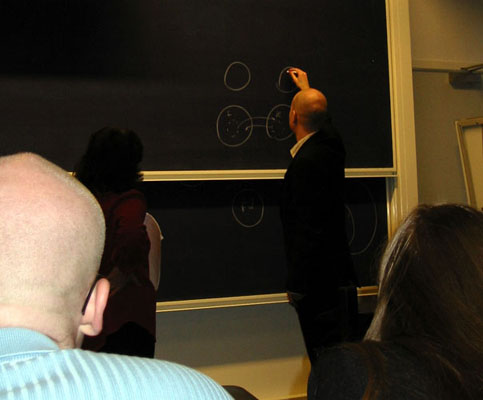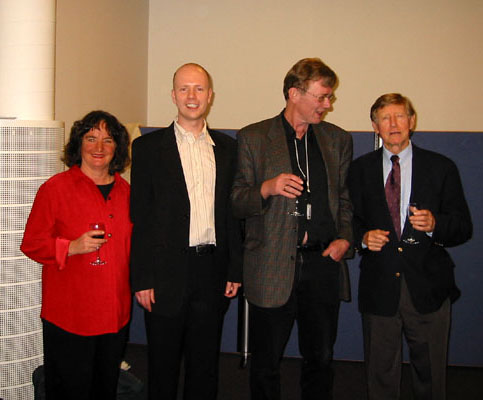Don’t know why I didn’t post it earlier, but here it is.
The defense is January 16th, 13:00 hours in room 0:19 at the IT University of Copenhagen, Glentevej 67, 2400 Copenhagen NV.
Half-Real: Video Games between Real Rules and Fictional Worlds
This dissertation aims to provide the basic components of a theory of video games. By video games I mean games played on personal computers, consoles, and other games played using computer processing and a video display.
The dissertation argues that there is a basic affinity between computers and games: computers and computer processing are commonly used for playing games, and the modern digital computer works as an enabler for games in the way that the printing press or cinema has worked as enablers for storytelling.
The central theme of the dissertation is the examination of video games as a constantly evolving tension between the rules and fictional worlds. The dissertation describes video games as two rather different things at the same time: video games are real in that they consist of real rules that players actually interact with; but fictional in that the worlds they project are just that, fictional. In this perspective, to playing a video game is to be engaged in the interaction with real rules while imagining a fictional world, and to design a video game is to design a set of rules as well as a fictional world.
Chapter 2 on the classic game model examines a number of previous game definitions in order to provide a new definition of games, a definition that describes games as working on three different levels: the level of the game itself, as a set of rules; the level of the player’s relation to the game; and the level of the relationship between the activity of playing the game and the rest of the world. The model is classic in the sense that almost all traditional games fit squarely inside this model, but the later part of the 20th century has seen a number of game forms – including some video games – that have developed beyond the classic model.
Additionally, the model does not tie games to any specific medium, and games are therefore transmedial in the same way that narrativity is transmedial. Video games are therefore best seen as a continuation of a long history of games, but video games have revolutionized games primarily by letting the computer handle the rules, thereby freeing players to focus on strategy and fictional worlds.
Chapter 3 on rules examines games as rule-based systems. I argue that rules in games offer affordances as well as limitations, and that the rule-based nature of games provides an explanation of the affinity between computers and games. This affinity extends to the theoretical realm in that many aspects of the rules of games can be understood through the lens of computer science. Games are basically state machines that proceed according to rules that have an algorithmic character: the rules of a game are designed to be unambiguous, definite and above discussion. I explain that this happens through a process of decontextualization, where each rule also includes a specification about what aspects of the game are relevant to the rule.
The dissertation argues that the rules of games produce an apparent paradox: while the rules of games are algorithmic, the enjoyment of a game depends on these rules presenting challenges that cannot be solved algorithmically. This takes different forms in different games but we can outline two basic ways in which games are structured and provide challenges for players: that of emergence (a number of simple rules combining to form interesting variations) and that of progression (separate challenges presented serially).
This leads to a player-oriented account of what it is to play a game: the player of a game will at any given point have a specific repertoire of strategies and methods for playing the game. Part of the attraction of a good game is that it continually challenges and makes new demands on the player’s repertoire.
Chapter 4 on fiction provides an account of the fictional aspect of games, an account that covers the spectrum from abstract games, to games with incoherent fictional worlds to games with detailed fictional worlds. To be able to discuss this spectrum, the theory of fictional worlds is employed to describe how the fictional world of a game can be optional for the player.
It is argued that the majority of games contain incoherent worlds: worlds that cannot fully be imagined due to incoherencies, but where the player accepts incoherence as a reflection of the rules of the game.
The importance of the game world varies on a scale from the highly replayable multi-player game (the emergence game) where the player gradually ceases to imagine the game world to, at the other extreme, the "complete-once" adventure game (the progression game), where the player only faces each setting once and therefore is more likely to take the fictional world at face value. A video game provides the player with the opportunity to imagine a fictional world. The player’s experience of the game world does not appear to require much consistency – the world of a game is rather something that the player can choose to imagine for a shorter or longer period of time, or not at all.
Chapter 5 on rules and fiction is the synthesis of the two previous chapters, and discusses the complex relationship between rules and fiction. While rules also construct the fictional world of a game, the fictional world also builds the player’s expectation of the rules of the game.
Rules and fiction rarely match completely: in most cases, the fictional world of the game will be larger and more detailed than what is implemented in the rules, but mismatches between rules and fictions can also generate positive effects, working as a way of playing with the player’s expectations, as a way of creating parody, and finally as a way of foregrounding the game as a real-world activity.
Methodologically, the dissertation is based upon an eclectic combination of theories and methods including literary theory, film theory, computer science, sciences of complexity, economic game theory, game design literature, and some psychology.

